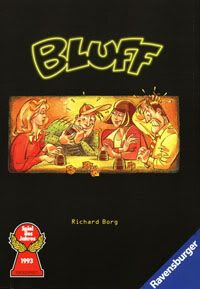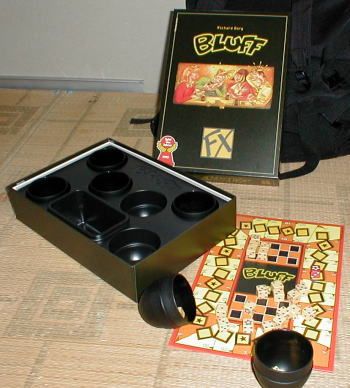
I’ve got a couple of copies of Richard Borg’s take on the game, marketed by Ravensburger under the name “Bluff”. This version of the game won Borg the 1993 Spiel des Jahres award, not bad for a reworking of a traditional game. The game comes in a nice box, and like most produced versions of the game it contains a betting guide board, six cups and thirty dice. Bluff’s dice are a bit smaller than standard, are colored orange, and have a star in place of the six. The cups are really nice, made of hard molded black plastic. They can stand a good deal of slamming. The board is your basic no-fold gloss-finish variety, with a betting track running around it and an area in the center for the eliminated dice. That area is grouped in fives, making it easy to tell how many dice are out of the game. Finally, there’s one red die to keep track of the bid on the board.
It’s not hard to make your own copy of Liar’s Dice, but it’s also nice playing with a well-made mass market version. Considering I got Bluff for around $12 each, I think it was a decent purchase.
The Game
Each edition of Liar’s Dice has the same basic gameplay, but there are tweaks in the rules. I’m talking about Borg’s Bluff rules below. If you have any variations, feel free to post them in replies to this review!
Each player takes a cup and begins the game with five dice. Everyone shakes their dice and then peeks at the result, keeping the dice hidden from everyone else beneath the cup. A randomly-selected start player begins the bidding.
Players are bidding on total die results among all players. So, at the beginning of the game, players are betting on results on 30 dice. The bid is for a number of results for a particular number. So, the start player might say “I think there are three 4s”. Well, okay, that’s a really weak bid, since in Bluff, the star is a wildcard and will represent any number that was bid. Basic probability says then that each number on the die can appear two out of six times, or a third of the time. A third of 30 dice is 10 4’s, so that’s a really weak, safe bet.
Anyway, the next player has two choice. He can up the bid on the bidding track, or he can call the previous player’s “bluff”. (Actually, everyone I know prefers to yell “Bullshit!” in various accents, intonations and volumes.) Upping the bid is done in two ways. A player can increment the die face, say, upping a bid of three 4s to three 5s (a raise that’s even weaker than the opening bid). Or, the player can increase the number of incidences. When he does this, he may change the die face bid to anything he likes (say, he’ll raise to six 1s or six 2s).
Since the stars are wild, they appear in the bidding track in the correct statistical order. Compared to the other five results, stars only occur a sixth of the time, so bidding stars is riskier.
Of course if you personally rolled a lot of stars, it’s not really a risk.

Once a player has called “Bullshit!” everyone reveals their dice. If the results are less than what was bid, the bidding player loses dice. If the results are more than the bid, the player who called Bullshit! loses dice. In both cases, the dice lost are equal to the difference between the bid and the results. If the results are exactly equal to the bid, each player other than the bidder loses one die, and is free to call the player who called Bullshit! whatever he wants for the next 30 seconds, in addition to whining and moaning.
Once that’s over with, the eliminated dice are placed in the center of the board, and everyone rolls again. Bidding begins to the left of the player who called the bluff.
The last player with any dice left wins!
Strategy
Hey, it’s all in the probabilities, the personal information (the dice under your own cup) and the expressions of the other players. Other than making the safest bids possible while making sure that a bid doesn’t come all the way around to you again on the same bid so you’re not in jeopardy twice in one sitting, there’s not much “strategy”. Moan and groan when someone makes you lose one die, complain that the dice are screwing you, and have fun!
Reviewer’s Tilt
If you can consider Liar’s Dice a party game, it’s one of my favorites. It’s also one of those games that can work with any kind of crowd, especially in a party atmosphere. I mentioned that I’ve got two copies, because the game can expand to any number of players. Just give a person a cup, some dice, and go. If the number of players somehow exceeds your production set, just find a paper cup and crib some dice from Risk. No, this isn’t a deep thinker, but it’s loads of fun, and because it’s easy to teach anyone can learn how to play in one minute. As fillers go, this is a game that belongs in every game collection.
No comments:
Post a Comment